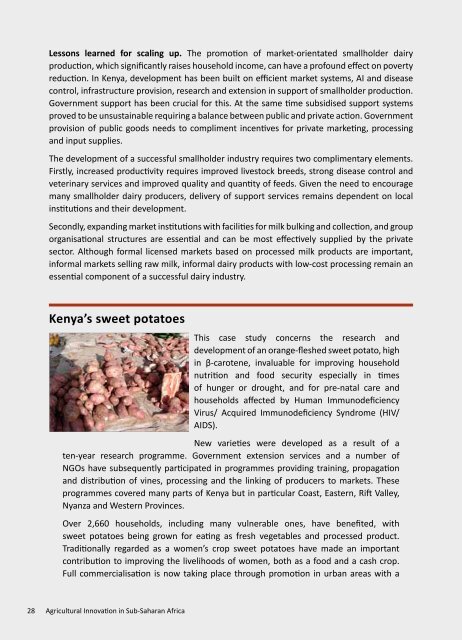1C1KKTs
1C1KKTs
1C1KKTs
Create successful ePaper yourself
Turn your PDF publications into a flip-book with our unique Google optimized e-Paper software.
Lessons learned for scaling up. The promotion of market-orientated smallholder dairy<br />
production, which significantly raises household income, can have a profound effect on poverty<br />
reduction. In Kenya, development has been built on efficient market systems, AI and disease<br />
control, infrastructure provision, research and extension in support of smallholder production.<br />
Government support has been crucial for this. At the same time subsidised support systems<br />
proved to be unsustainable requiring a balance between public and private action. Government<br />
provision of public goods needs to compliment incentives for private marketing, processing<br />
and input supplies.<br />
The development of a successful smallholder industry requires two complimentary elements.<br />
Firstly, increased productivity requires improved livestock breeds, strong disease control and<br />
veterinary services and improved quality and quantity of feeds. Given the need to encourage<br />
many smallholder dairy producers, delivery of support services remains dependent on local<br />
institutions and their development.<br />
Secondly, expanding market institutions with facilities for milk bulking and collection, and group<br />
organisational structures are essential and can be most effectively supplied by the private<br />
sector. Although formal licensed markets based on processed milk products are important,<br />
informal markets selling raw milk, informal dairy products with low-cost processing remain an<br />
essential component of a successful dairy industry.<br />
Kenya’s sweet potatoes<br />
This case study concerns the research and<br />
development of an orange-fleshed sweet potato, high<br />
in β-carotene, invaluable for improving household<br />
nutrition and food security especially in times<br />
of hunger or drought, and for pre-natal care and<br />
households affected by Human Immunodeficiency<br />
Virus/ Acquired Immunodeficiency Syndrome (HIV/<br />
AIDS).<br />
New varieties were developed as a result of a<br />
ten-year research programme. Government extension services and a number of<br />
NGOs have subsequently participated in programmes providing training, propagation<br />
and distribution of vines, processing and the linking of producers to markets. These<br />
programmes covered many parts of Kenya but in particular Coast, Eastern, Rift Valley,<br />
Nyanza and Western Provinces.<br />
Over 2,660 households, including many vulnerable ones, have benefited, with<br />
sweet potatoes being grown for eating as fresh vegetables and processed product.<br />
Traditionally regarded as a women’s crop sweet potatoes have made an important<br />
contribution to improving the livelihoods of women, both as a food and a cash crop.<br />
Full commercialisation is now taking place through promotion in urban areas with a<br />
28 Agricultural Innovation in Sub-Saharan Africa


